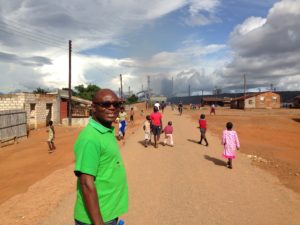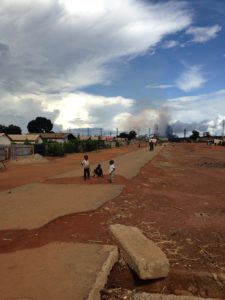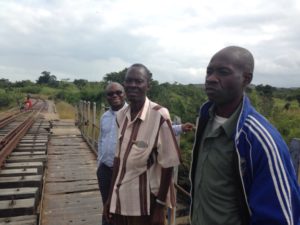
“A crouching vicious beast of prey whose snorts grow ever louder as if choking on its painful digestion of human flesh”. Thus goes Émile Zola’s description of a vast coal mine in his novel Germinal about a mid-nineteenth century coal mining community in northern France.
Under Zola’s analysis, if the vicious beast is choking, so are the people living in its midst. At least this is the case with two mining communities I experienced earlier this week when I accompanied a Zambian Jesuit, Fr. Charles Chilufya SJ, in some fieldwork examining environmental and social degradation caused by large-scale mining. We visited Kankoyo and Chingola, two townships situated approximately 50km north of Kitwe in the Copperbelt region of northern Zambia.
Kankoyo – sulphur fumes and unemployment
Kankoyo sits in the shadow of the Mufulira mine, smelter, concentrator and refinery. Producing 35,000 tonnes of copper ore each year, it is one of the world’s largest copper mines. When we arrived, the air was thick with sulphur and dust. The poverty-stricken houses almost touch the perimeter fence of the heavily security-guarded Mufulira plant. At one point, walking on the dirt road through the township, alongside which runs an open sewer, I found myself on verge of choking from the overpowering fumes emanating from the refinery. Meanwhile kids around us played, and the life of the residents went on.
It was a Sunday afternoon.
Mufulira is owned by Mopani Copper Mines, of which the global mining giant Glencore has a majority stake. Incredibly profitable, according to the European Investment Bank, Mopani has generated at least $560 million in tax revenues for Zambian government coffers since 2000.

Why then do its neighbours live in abject poverty, suffering from unemployment and harm to health? Fr. Chilufya, who is student chaplain and a lecturer in business and economics at Copperbelt University, explained to me that problems of Kankoyo derive from the Zambian Government’s zealous embracing of Neo-Liberal economics in the late 1990s. With encouragement from international governments and financial institutions, including the European Investment Bank, previously state-owned companies like Mopani were privatised. Almost overnight, jobs and services previously provided by the state mining company vanished.
The new private companies rationalised their operations, recruiting many non-Zambian employees, automising processes and vastly reducing employment of local people. Communities of former mine workers, like Kankoyo, quickly became ghettos plagued by alcoholism and prostitution. The people of these towns see nothing of the mine tax revenues and they are likely to die prematurely from the effects of pollution because state regulators do not compel companies to improve conditions. The wretched conditions of Kankoyo are documented in a 2012 film “Zambia: Good Copper, Bad Copper” produced by Alice Odiot and Audrey Gallet written in collaboration with Stéphane Horel.
The complete failure of state regulators to enforce against mining companies who cause serious pollution was a factor that led us to visit Chingola.
Chingola – water poisoning and community action

As with Kankoyo, Chingola is an impoverished township of mostly former mine workers. Close by is Konkola Copper Mines (KCM) which is held by the Indian-owned, although London-registered, company, Vedanta. In 2006 KCM spilled a huge quantity of raw copper, manganese and cobalt effluents into the Mushishima and Kafue rivers which supply water to households in Chingola. Thousands were poisoned, leading to serious sickness and suspected premature deaths.
Outraged by the KCM’s negligence and the Zambia State’s failure to act against KCM, the residents of Chingola launched a legal action. In 2011 their claim succeeded in the High Court, which ordered KCM to pay a total of $2 million to 2000 residents in Chingola. However KCM appealed to the Supreme Court. Whilst the Supreme Court upheld the High Court decision, KCM managed to persuade the Supreme Court judges to make it more difficult for residents to get damages by requiring claimants to obtain expensive medical reports. As such, to date, none of the residents have received any compensation.
Knowing a little of the background to the case, it was a great privilege for Fr. Chilufya and I to meet up with its lead claimant, Mr. James Nyasulu. James invited us to into his simple single-story house in Chingola. We were joined by Joseph, also a participant in the legal action, and another former miner. A family man, James explained that his chief goal in organising the case was to prevent future pollution, and to ensure basic health for his children. He expressed his sadness that the Supreme Court decision meant that residents were effectively barred from obtaining a legal remedy that the High Court had insisted upon. He explained that what grieved him most was the dishonest conduct of government officials and members of the legal profession throughout the case. He wants to continue in pursuing justice for Chingola residents.

Perhaps the most distressing aspect of Chingola’s situation is that KCM appears to continue to contaminate the Mushishima river. James and Joseph took us to see the river. Right enough, there were visible signs that the water was laden with copper deposits. Tree branches and grass next to the water were dead, and toxic foam accumulated against rocks.
Future involvement with Copperbelt University
Fr. Chilufya wants to raise awareness of the plight of Kankoyo and Chingola. His hope is to build a partnership between the students of Copperbelt University and the residents of these townships. This partnership would help raise consciousness among Zambia’s future leaders. At the same time, it could open up potential opportunities for university staff and students to undertake environmental and social analysis. The towns of Kankoyo and Chingola are “frontiers” says Fr. Chilufya, insisting that our advocacy should have the objective of allowing the voice of those at the margins to be heard.

